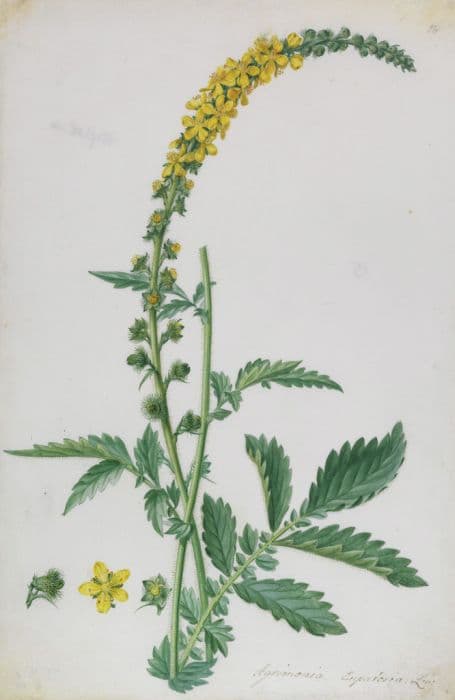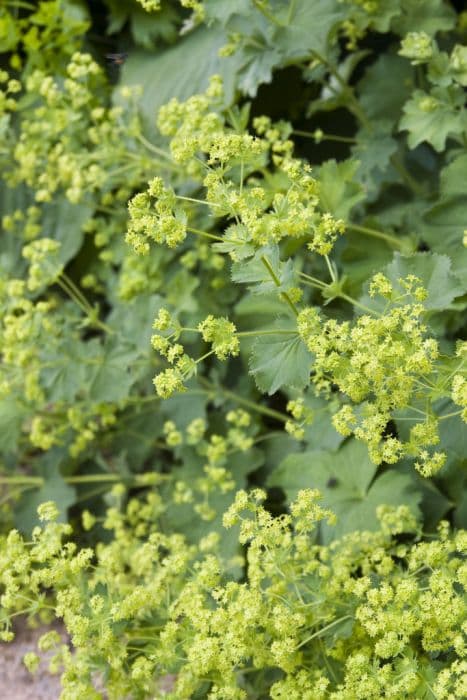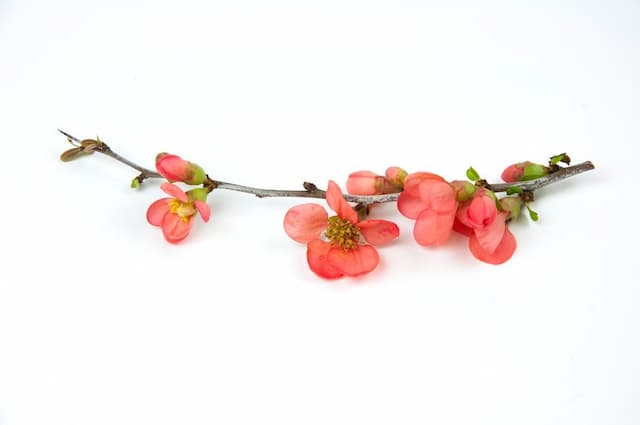Avens Geum 'Georgenberg'

ABOUT
The Geum 'Georgenberg' is a flowering perennial known for its vibrant and showy blossoms. The flowers display unique shades that can range from a rich apricot to a warm orange, often with a delightful gradient transitioning between these hues. The petals are rounded and slightly overlap one another, giving the blooms a full and inviting appearance. These flowers sit atop long, slender stems which elegantly rise above the foliage. The leaves of Geum 'Georgenberg' form a dense clump and are often deeply lobed, with edges that can be toothed or have a slightly ruffled texture. The foliage is a lush green, providing a lovely contrast to the bright tones of the flowers. This hardy plant tends to bloom profusely in the late spring and can continue flowering into the summer months, delivering an extended display of color in gardens and landscapes.
About this plant
 Names
NamesFamily
Rosaceae
Synonyms
Avens
Common names
Geum 'Georgenberg'.
 Toxicity
ToxicityTo humans
The Geum 'Georgenberg', commonly known as avens, does not have a well-documented profile of toxicity to humans. It is generally considered non-toxic, and there is no widespread evidence of poisonous effects from ingesting this plant. As with any plant material, individual allergies or sensitivities are possible, and thus caution should be exercised if you are not sure about potential reactions.
To pets
Avens, the common name for Geum 'Georgenberg', is also generally recognized as non-toxic to pets. There is no significant evidence to suggest that ingestion of avens leads to poisoning in animals. Nevertheless, pet owners should always monitor their animals for any unusual behavior if they consume plant material, as individual reactions may vary.
 Characteristics
CharacteristicsLife cycle
Perennials
Foliage type
Deciduous
Color of leaves
Green
Flower color
Orange
Height
1-2 feet (30-60 cm)
Spread
1-2 feet (30-60 cm)
Plant type
Herb
Hardiness zones
5
Native area
Europe
Benefits
 General Benefits
General Benefits- Attracts Pollinators: The Geum 'Georgenberg', commonly known as Avens, produces flowers that attract bees and beneficial insects, which is crucial for pollination and maintaining healthy ecosystems.
- Easy to Grow: Avens are known for being hardy and easy to cultivate, making them a popular choice for gardeners of all skill levels.
- Aesthetic Appeal: With its bright, colorful blooms, Avens add visual interest and beauty to any garden or landscape design.
- Long Blooming Period: Avens have a relatively long flowering season, providing color and vibrancy to gardens for an extended period.
- Drought Tolerance: Once established, Avens are fairly drought-tolerant, reducing the need for frequent watering and making them suitable for xeriscaping or regions with low water availability.
- Low Maintenance: Requiring minimal care, Avens are an ideal plant for low-maintenance landscaping, requiring only occasional deadheading and division to keep them thriving.
- Wildlife Habitat: The dense foliage of Avens provides shelter and nesting sites for small wildlife, contributing to biodiversity.
- Soil Erosion Control: The root system of Avens helps to stabilize soil and prevent erosion, particularly on slopes or in areas with loose soil.
- Edging and Borders: Due to their compact growth habit, Avens are perfect for creating defined edges and borders in garden beds and pathways.
- Culinary Uses: Although not a medical benefit, some parts of avens are edible and can be used in salads or as a garnish, adding a unique flavor to dishes.
 Medical Properties
Medical PropertiesThis plant is not used for medical purposes.
 Air-purifying Qualities
Air-purifying QualitiesThis plant is not specifically known for air purifying qualities.
 Other Uses
Other Uses- The dried petals of Geum can be used to add color to potpourri mixes, providing a natural and aesthetically pleasing element to homemade potpourri.
- Pressed Geum flowers can become part of botanical art projects like handmade greeting cards, bookmarks, or framed plant art.
- Geum flowers can be used in floral arrangements as a fresh cut flower, offering a bright, long-lasting bloom that adds texture and interest.
- The flowers of the Geum plant can be used as a natural dye for fabrics, yarns, or paper, giving a range of colors from yellows to orange hues.
- Geum leaves and flowers can be used in crafting eco-printed materials where the natural shapes and colors are transferred to paper or textiles.
- The petals of Geum can be candied to decorate desserts, providing an edible garnish with a subtle flavor and attractive appearance.
- In gardening, Geum plants can be used as part of companion planting strategies to attract pollinators like bees and butterflies to the garden.
- The seeds of Geum can be collected and used in seed swap events among gardeners, promoting biodiversity and sharing of various plant species.
- Geum can provide a natural ground cover in garden designs, reducing weed growth and minimizing soil erosion with its foliage.
- Edible landscapes can include Geum for its ornamental value, adding visual appeal to gardens where aesthetic and functionality are equally important.
Interesting Facts
 Feng Shui
Feng ShuiThe Geum or Avens is not used in Feng Shui practice.
 Zodiac Sign Compitability
Zodiac Sign CompitabilityThe Geum or Avens is not used in astrology practice.
 Plant Symbolism
Plant Symbolism- Passion: Geum varieties, with their bright and fiery blooms, often represent passionate emotions and an ardent attachment.
- Healing: Historically, Geum species have been used in herbal medicine, symbolizing healing and the alleviation of various ailments.
- Vitality: The vibrant and hardy nature of these flowers embodies a sense of vitality and the ability to thrive in diverse conditions.
- Cheerfulness: The Geum's cheerful flowers often signify positivity and the brightening of one's day, representing joy and good cheer.
- Perseverance: Due to their resilient growth habit, Geums can symbolize determination and the ability to persist through challenges.
 Water
WaterAvens, commonly known as Geum 'Georgenberg', should be watered deeply once a week, allowing the soil to dry out slightly between waterings. The amount of water needed can vary depending on the climate and soil conditions, but generally, giving the plant about 1 inch of water weekly is sufficient. During hot, dry spells, you might need to water twice a week, whereas in cooler, wetter periods, less frequent watering will be necessary. Ensure the water penetrates the soil to reach the plant's deeper roots, but avoid overwatering, which can lead to root rot.
 Light
LightAvens, or Geum 'Georgenberg', thrives best in full sun to partial shade. The ideal spot for this plant would receive morning sunlight and some afternoon shade to protect it from the intense heat of the day. Ensure that the plant gets at least 4-6 hours of sunlight daily for optimal growth and flower production.
 Temperature
TemperatureAvens, known as Geum 'Georgenberg', prefers cooler temperatures and can generally tolerate temperatures down to 20°F but may be damaged by temperatures below 0°F. The ideal temperature range for this plant is between 60°F to 75°F during its active growing season. Avens are hardy, though, and once established, they can withstand a wide range of temperatures including the hot spells of summer.
 Pruning
PruningAvens, the common name for Geum 'Georgenberg', should be deadheaded regularly to encourage further blooming and maintain a neat appearance. Prune spent flowers back to the base of the flower stem. In early spring or after the first flush of flowers, cut back the foliage to promote new, healthy growth. The best time for a more thorough pruning is after the plant has finished its main flowering period.
 Cleaning
CleaningAs needed
 Soil
SoilAvens (Geum 'Georgenberg') thrives best in a well-drained, fertile loamy soil with a pH of 5.5 to 7.0. A mix of garden soil, compost, and sharp sand or perlite can create an ideal growing medium for this perennial plant.
 Repotting
RepottingAvens (Geum 'Georgenberg') does not need frequent repotting and can be repotted every two to three years, or when the plant becomes root-bound in its current pot.
 Humidity & Misting
Humidity & MistingAvens (Geum 'Georgenberg') prefers moderate humidity levels, but being a garden perennial, it is quite adaptable and doesn't require specific humidity control when planted outdoors.
 Suitable locations
Suitable locationsIndoor
Place Avens near a window; ensure bright, indirect light.
Outdoor
Plant in sun to partial shade, enrich soil, water regularly.
Hardiness zone
5-7 USDA
 Life cycle
Life cycleThe Geum 'Georgenberg', commonly known as Avens, starts its life as a seed, which when sown in fertile, well-drained soil and exposed to the right conditions (light, moisture, temperature), will germinate. The seedling then emerges and develops true leaves, forming a small rosette at the soil level as it enters the vegetative growth stage, relying on sunlight and nutrients to grow larger. As the plant matures, it enters the reproductive stage, producing tall stems with buds that bloom into attractive flowers, usually in late spring to summer, and are pollinated by insects. Following pollination, the flowers develop into fruit which contains seeds, completing the cycle. Over the years, the Avens will form clumps as it becomes a perennial presence in the garden, dying back to the ground during the winter to re-emerge in spring. Regular division of the plant may be necessary to prevent overgrowth and to encourage vigorous flowering.
 Propogation
PropogationPropogation time
Spring-Early Summer
The Geum 'Georgenberg', commonly known as Avens, can be propagated by division, which is the most popular method for this perennial plant. The best time to divide Avens is in early spring or fall when the plant is not in active growth. To propagate through division, carefully dig up the entire plant and gently separate it into smaller clumps, ensuring that each clump has a portion of the root system and several shoots. Replant the divisions at the same soil depth they were originally growing at, spacing them about 12 to 18 inches (30 to 45 centimeters) apart to provide ample room for growth. Keep the soil moist as the new divisions establish themselves. This method allows gardeners to create new plants that are true to the parent plant and helps to rejuvenate older clumps that may have become woody or less vigorous.









